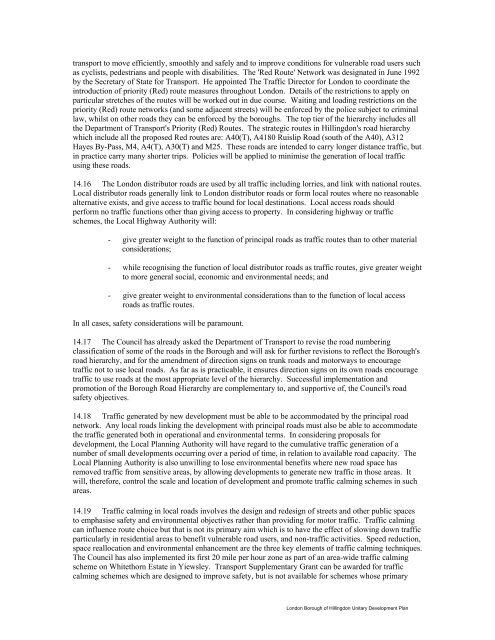HILLINGDON UNITARY DEVELOPMENT PLAN - London Borough ...
HILLINGDON UNITARY DEVELOPMENT PLAN - London Borough ...
HILLINGDON UNITARY DEVELOPMENT PLAN - London Borough ...
You also want an ePaper? Increase the reach of your titles
YUMPU automatically turns print PDFs into web optimized ePapers that Google loves.
transport to move efficiently, smoothly and safely and to improve conditions for vulnerable road users such<br />
as cyclists, pedestrians and people with disabilities. The 'Red Route' Network was designated in June 1992<br />
by the Secretary of State for Transport. He appointed The Traffic Director for <strong>London</strong> to coordinate the<br />
introduction of priority (Red) route measures throughout <strong>London</strong>. Details of the restrictions to apply on<br />
particular stretches of the routes will be worked out in due course. Waiting and loading restrictions on the<br />
priority (Red) route networks (and some adjacent streets) will be enforced by the police subject to criminal<br />
law, whilst on other roads they can be enforced by the boroughs. The top tier of the hierarchy includes all<br />
the Department of Transport's Priority (Red) Routes. The strategic routes in Hillingdon's road hierarchy<br />
which include all the proposed Red routes are: A40(T), A4180 Ruislip Road (south of the A40), A312<br />
Hayes By-Pass, M4, A4(T), A30(T) and M25. These roads are intended to carry longer distance traffic, but<br />
in practice carry many shorter trips. Policies will be applied to minimise the generation of local traffic<br />
using these roads.<br />
14.16 The <strong>London</strong> distributor roads are used by all traffic including lorries, and link with national routes.<br />
Local distributor roads generally link to <strong>London</strong> distributor roads or form local routes where no reasonable<br />
alternative exists, and give access to traffic bound for local destinations. Local access roads should<br />
perform no traffic functions other than giving access to property. In considering highway or traffic<br />
schemes, the Local Highway Authority will:<br />
- give greater weight to the function of principal roads as traffic routes than to other material<br />
considerations;<br />
- while recognising the function of local distributor roads as traffic routes, give greater weight<br />
to more general social, economic and environmental needs; and<br />
- give greater weight to environmental considerations than to the function of local access<br />
roads as traffic routes.<br />
In all cases, safety considerations will be paramount.<br />
14.17 The Council has already asked the Department of Transport to revise the road numbering<br />
classification of some of the roads in the <strong>Borough</strong> and will ask for further revisions to reflect the <strong>Borough</strong>'s<br />
road hierarchy, and for the amendment of direction signs on trunk roads and motorways to encourage<br />
traffic not to use local roads. As far as is practicable, it ensures direction signs on its own roads encourage<br />
traffic to use roads at the most appropriate level of the hierarchy. Successful implementation and<br />
promotion of the <strong>Borough</strong> Road Hierarchy are complementary to, and supportive of, the Council's road<br />
safety objectives.<br />
14.18 Traffic generated by new development must be able to be accommodated by the principal road<br />
network. Any local roads linking the development with principal roads must also be able to accommodate<br />
the traffic generated both in operational and environmental terms. In considering proposals for<br />
development, the Local Planning Authority will have regard to the cumulative traffic generation of a<br />
number of small developments occurring over a period of time, in relation to available road capacity. The<br />
Local Planning Authority is also unwilling to lose environmental benefits where new road space has<br />
removed traffic from sensitive areas, by allowing developments to generate new traffic in those areas. It<br />
will, therefore, control the scale and location of development and promote traffic calming schemes in such<br />
areas.<br />
14.19 Traffic calming in local roads involves the design and redesign of streets and other public spaces<br />
to emphasise safety and environmental objectives rather than providing for motor traffic. Traffic calming<br />
can influence route choice but that is not its primary aim which is to have the effect of slowing down traffic<br />
particularly in residential areas to benefit vulnerable road users, and non-traffic activities. Speed reduction,<br />
space reallocation and environmental enhancement are the three key elements of traffic calming techniques.<br />
The Council has also implemented its first 20 mile per hour zone as part of an area-wide traffic calming<br />
scheme on Whitethorn Estate in Yiewsley. Transport Supplementary Grant can be awarded for traffic<br />
calming schemes which are designed to improve safety, but is not available for schemes whose primary<br />
<strong>London</strong> <strong>Borough</strong> of Hillingdon Unitary Development Plan
















